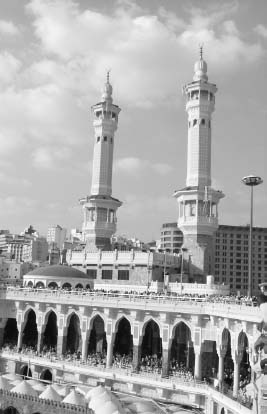IslamHolidays and Regular Observances |
When do Muslims make pilgrimage to Mecca and what do they do there? |
Formal season for the greater pilgrimage, called the Hajj, occurs between the eighth and thirteenth day of the twelfth lunar month. The journey is required of all Muslims with sufficient health and financial resources, assuming also that making the Hajj would not require them to shirk serious family responsibilities at home. As pilgrims enter a “forbidden zone” that encircles Mecca (called the haram), they put on the plain white wraps called the ihram (pronounced ihRAAM). The garb marks a transition to sacred space and time and reminds pilgrims of their simple equality before God.
Though precise ritual activities depend on both variations within the four Sunni law schools as well as on whether or not pilgrims intend to combine Hajj with ‘Umra (lesser pilgrimage), the following offers an idea of the major elements of Hajj. On the first day (the 8th of the month) they usually circumambulate the Ka’ba seven times, pray at the Station of Abraham, pray two cycles of prostrations, and drink from the spring of Zamzam. Heading for Mina outside of Mecca, most pilgrims will stay overnight there before moving on to the plain of Arafat. They stand before the Mount of Mercy, recalling the deeds of Muhammad and Abraham there long ago. That evening they go a short distance back toward Mecca, to Muzdalifa, where on the third day they celebrate the Feast of Sacrifice (‘Id al-Adha). Moving back to Mina later that day, pilgrims cast seven stones at one of three pillars, a symbolic repudiation of the temptations of Satan. After a symbolic clipping or shaving of hair, pilgrims remove the ihram and return to Mecca to circumambulate the Ka’ba and run seven times between the hills Safa and Marwa to commemorate Hagar’s frantic search for water. During the eleventh through thirteenth days, pilgrims remain at Mina, casting the remainder of forty-nine stones collected earlier at all three of the pillars. Those who did not participate in the sacrifice on the tenth day may do so now. To end the whole event, most will again circumambulate the Ka’ba seven times. In recent years the Saudi government has expanded their pilgrimage facilities dramatically in order to accommodate annual crowds now numbering two million or more.

Two of the nine minarets at the Haram Mosque in Mecca. (Ahmad Faizal Yahya / Shutterstock.com.)
